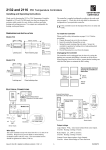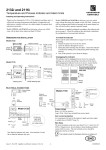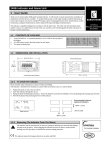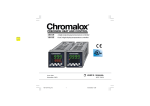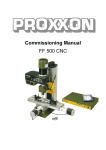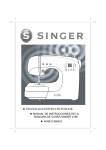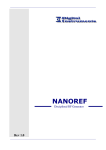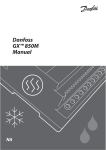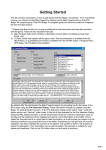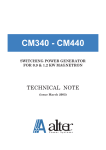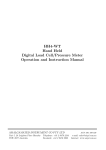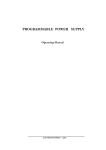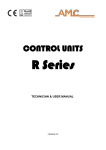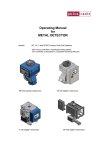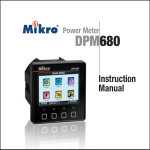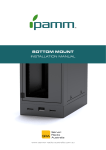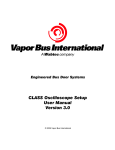Download 0216, 0316 User Manual
Transcript
0216 0316 PID CONTROLLERS U USER MANUAL 02_0316_A_DER.pmd 1 23/04/2004, 10.48 INDEX GB A . WHAT YOU NEED TO KNOW BEFORE YOU S T A R T ................................................................... A . 2 A.1 OUTLINE AND CUT OUT DIMENSIONS ............. A.5 1 . MOUNTING .............................................................. 1 2 . ELECTRICAL CONNECTIONS ............................... 2 3 . PRELIMINARY HARDWARE SETTINGS 6 4 . CONFIGURATION ................................................... 6 4.1 Pushbutton function ............................................ 6 4.2 Possible protection of the parameters ................ 6 4.3 Access to the configuration procedure ............... 7 4.4 Configuration parameters .................................... 7 5 . OPERATIVE MODE ............................................... 1 4 5.1 Preliminary comments ....................................... 14 5.2 SMART algorithm ............................................... 15 5.3 Inhibition of the out signal ................................. 15 5.4 Displaying the set point set (model LDE) ........................................................ 16 5.5 SP/SP" selection ............................................... 16 5.6 Direct modification of the set point ................... 16 5.7 Timer mode description ..................................... 16 5.8 Manual reset of the alarm ................................. 20 5.9 Soft Start Ffunction ........................................... 20 5.10 Lamp test ........................................................... 20 5.11 Function of the pushbuttons ............................. 20 5.12 Indicators ........................................................... 21 5.13 Operative parameters ........................................ 21 6 . ERROR MESSAGES ............................................ 2 4 6.1 Measurement anomaly signal .......................... 24 6.2 Error messages ................................................. 25 6.3 List of possible errors ....................................... 25 7 . TECHNICAL CHARACTERISTICS ...................... 2 6 7.1 Technical specifications .................................... 26 7.2 Inputs ................................................................. 27 7.3 Control actions ................................................... 27 7.4 Outs ................................................................... 28 7.5 CPI - Configuration Port Interface ..................... 28 8 . MAINTENANCE ...................................................... 2 8 B . DEFAULT PARAMETERS .................................. B . 1 A. 1 02_0316_A_DER.pmd 2 23/04/2004, 10.48 A. EUROTHERM CONTROLLER MODELS 0216 / 0316 What you need to know before you start Home Screen Definition Model 0216 displays the measured value or the operating set point. When the timer is running, time remaining is displayed. LED “A” flashing indicates the timer is running, LED “B” flashing indicates SP2 is selected as the operating set point. To select between the set point display and the measured value press pushbutton V. Model 0316 displays the measured value on the upper display. The lower display indicates the operating set point or the time remaining when the timer is running. LED “A” flashing indicates the timer is running, LED “B” flashing indicates SP2 is selected as the operating set point. A. 2 02_0316_A_DER.pmd 3 23/04/2004, 10.49 CONFIGURATION ENTRY & EXIT DIRECT SETPOINT ENTRY See page 16 section 5.6 While viewing the normal display hold either the V or W button for more than 2 seconds. The value will change. After reaching the new set point do not press any keys for a further 2 seconds and the new value will be entered. E n t r y See operator manual page 7 section 4.3 To gain access to configuration you need to be in the HOME screen. While in the HOME screen press the PAGE key followed by the SCROLL key Keep both keys pressed for 3 seconds until the ConF. display shows OFF and ConF Now press either s or t to gain access by changing OFF to ON ON. PARAMETER ENTRY See page 21 section 5.11 Whenever a parameter is changed using either the V or W buttons there are 2 options: Exit See operator manual page 14 after P28 To exit configuration you need to be at the Conf screen While in the Conf screen press the PAGE key followed by the SCROLL key Keep both keys pressed for 3 seconds until the display returns to normal numeric display. Accept new value Press the SCROLL key Cancel the change Press the PAGE key LAMP TEST POWER OUTPUT On/Off See page 21 section 5.10 The instrument display LED’s can be tested as follows: These products allow you manually turn off the output power. See page 16 section 5.3 Activate Test Press W and Press W and Cancel Test Off To turn the power off press the V key followed by the SCROLL key. Keep both buttons pressed for 3 seconds until the display shows OFF. On To tune the power on press the V key followed by the SCROLL key. Keep both buttons pressed for 3 seconds until the display returns to normal numeric display. A. 3 02_0316_A_DER.pmd 4 23/04/2004, 10.49 together together DEFAULT CONFIGURATION TIMER CONTROL FROM FRONT PANEL KEYS See section B The instrument can be pre-loaded with factory default values. Using the factory default values is ideal for completely resetting the instrument before commencing a new configuration. See page 17 section 5.7 When a timer funtion is configured the parameter ‘StS’ is enabled. This parameter functions the same as that described for a digital input. ‘StS’ = ‘OFF’ means that the time is off PARAMETER SECURITY ‘StS’ = ‘On’ means that the timer is on. See page 6 section 4.2, and page 10 section P11 & P14 The instrument is supplied with access to the main parameters which are required for the set-up procedure. After commissioning it is necessary to select the correct level of Parameter Security, simplifing the instrument user interface for normal operation. The most common security setting would be: P11 = 1 P14 = Off RECOVERY FROM A LOST PASSWORD See page 6 section 4.2, and page 10 section P11 & P14 If you lose your password Enter Configuration using the Master Code of 408 Go to parameter P11 and enter the Master Code of 408 You can now reset the password. A. 4 02_0316_A_DER.pmd 5 23/04/2004, 10.49 A.1 OUTLINE AND CUT OUT DIMENSIONS 0216 EUROTHERM 0316 0 21 6 EUROTHERM A. 5 02_0316_A_DER.pmd 6 23/04/2004, 10.49 0 31 6 1. MOUNTING screws bracket gasket panel Select a mounting location where there is minimum vibration and the ambient temperature ranges between 0 and 50°C (32 and 122°F). The instrument can be mounted on a panel up to 15 mm thick with a square cutout of 45 x 45 mm. For outline and cutout dimensions refer to page A.4. The surface texture of the panel must be better than 6.3 µm. The instrument is fitted with a rubber panel gasket. To assure IP65 and NEMA 4 protection, insert the panel gasket between the instrument and the panel as shown in Fig. 1. While holding the instrument against the panel proceed as follows: 1) insert the gasket in the instrument case; 2) insert the instrument in the panel cutout; 3) pushing the instrument against the panel, insert the mounting bracket; 4) with a screwdriver, turn the screws with a torque between 0.3 and 0.4 Nm. GB 02-0316-1-DER.pmd 1 Fig. 1 PANEL MOUTING 1 22/04/2004, 16.19 2. ELECTRICAL CONNECTIONS MEASURING INPUTS NOTE NOTE: Any external components (like zener barriers etc.) connected between sensor and input terminals may cause errors in measurement due to excessive and/or not balanced line resistance or possible leakage currents. Connections are to be made with the instrument housing installed in its proper location. TC INPUT + 10 _ 9 Shield + 10 _ 9 + Shield Fig. 3 NOTES NOTES: 1) Do not run input wires together with power line cables. 2) For TC wiring use proper compensating cable preferably shielded. 3) When a shielded cable is used, it should be connected at one point only. Fig. 2 REAR TERMINAL BLOCK GB 02-0316-1-DER.pmd THERMOCOUPLE CONNECTION 2 2 22/04/2004, 16.19 LOGIC INPUT Safety note: 1) Do not run logic input wiring together with power cables. 2) Use an external dry contact capable of switching 8 mA, 8 V DC. 3) The instrument needs 300 ms to recognize a contact status variation. 4) The logic input is NOT isolated by the measuring input RTD INPUT RTD 8 9 RTD 10 8 9 Log. input 2 10 11 12 Fig. 4 RESISTANCE TEMPERATURE DETECTOR CONNECTION NOTES NOTES: 1) Do not run input wires together with power line cables. 2) Pay attention to the line resistance; a resistance higher than 20 Ω/wire may cause measurement errors. 3) When shielded cable is used, it should be grounded at one side only to avoid ground loop currents. 4) The impedence of the 3 wires must be the same. GB 02-0316-1-DER.pmd 3 Fig. 5 - LOGIC INPUT WIRING The logic input can be programmed as: A) Set point selector A.1) In this case it will operate as follows: logic input operat. set point open SP close SP2 B) Start timer In this case it will operate as described at paragraph 5.7 (Timer modes description). 3 22/04/2004, 16.19 RELAY OUTS 3 OUT 1 2 1 3) 4) NC C Use copper conductors only. Do not run input wires together with power line cables. The following recommendations avoid serious problems which may occur it when using relay output to drive inductive loads. NO INDUCTIVE LOADS OUT 2 6 7 OUT 3 15 14 C High voltage transients may occur when switching inductive loads. These transients may introduce disturbances through the internal contacts which can affect the performance of the instrument. The internal protection (varistors) assures correct protection up to 0.5 A of inductive component but the OUT 1 NC contact is not protected. The same problem may occur when a switch is used in series with the internal contacts. NO C NO Fig. 6 RELAY OUTS C The OUT 1 NO contact and the OUT 2 and OUT 3 contacts are protected by varistors against inductive load with inductive component up to 0.5 A. The OUT 1 contact rating is 3A/250V AC on resistive load. The OUT 2 and OUT 3 contact rating is 2A/250V AC on resistive load. The number of operations is 1 x 105 at specified rating. 02-0316-1-DER.pmd 4 POWER LINE LOAD Fig. 7 EXTERNAL SWITCH IN SERIES WITH THE INTERNAL CONTACT In these cases an additional RC network should be installed across the external contact as shown in Fig. 7 The value of the capacitor (C) and resistor (R) are shown in the following table. NOTES: 1) To avoid electric shock, connect the power line at the end of the wiring procedure. 2) For power connections use No 16 AWG or larger wires rated for at least 75°C. GB R 4 22/04/2004, 16.19 R (W) P. (W) OPERATING VOLTAGE <40 mA 0.047 100 <150 mA 0.1 22 <0.5 A 0.33 47 1/2 2 2 260 V AC 260 V AC 260 V AC POWER LINE WIRING 5 4 In every case the cable connected to the relay outs must be routed as far away as possible from input or communication cables. OUT 1 + _ 1 SOLID STATE RELAY Fig. 8 SSR DRIVE OUT WIRING It is a time proportioning out. 0 Vout < 0.5 V DC. Logic level 0: Logic level 1 1: Maximum current = 20 mA. - 14 V + 20 % @ 20 mA - 24 V + 20 % @ 1 mA. NOTE NOTE: This out is NOT isolated. A double or reinforced Isolation between instrument output and power supply must be assured by the external solid state relay. GB 02-0316-1-DER.pmd 5 R (S,T) NOTES NOTES: 1) Before connecting the instrument to the supply, make sure that the line voltage corresponds to that indicated on the rating plate. 2) To avoid electric shock, connect the power line at the end of the wiring procedure. 3) For supply connections use No 16 AWG or larger wires rated for at least 75°C. 4) Use copper conductors only. 5) Do not run input wires together with power line cables. 6) For 24 V AC/DC the polarity does not matter. 7) The power supply input has NO fuse protection. Please, provide a T type 1A, 250 V fuse externally. 8) The safety regulations for equipment permanently connected to the mains require that there is a switch or circuit breaker in the building electrical system and that this: - is near the device and can easily be reached by the operator; - is marked as the device ON/OFF device. + _ Power Line 100 V to 240 V AC (50/60Hz) or 24 V AC/DC Fig. 9 POWER LINE WIRING VOLTAGE OUTS FOR SSR DRIVE 2 N N C (mF) R (S,T) LOAD (mA) NOTE NOTE: A single switch or circuit-breaker can drive more than one instrument. 5 22/04/2004, 16.19 3 . PRELIMINARY HARDWARE SETTINGS 4 . CONFIGURATION 4 . 1 PUSHBUTTON FUNCTION This saves the new value of the selected parameter and goes to the next parameter (increasing order). This scrolls back the parameters without saving the new value. This increases the value of the selected parameter. This decreases the value of the selected parameter. These instruments can detect the opening of the input circuit (TC or RTD). This failure is displayed as an overrange condition. For the thermocouples only one can select, by means of jumpers SH1 and CH1 indicated in Fig. 9, the type of indication to be obtained when the thermocouple is open (see table at the bottom of the page). To gain access to the jumpers the instrument must be taken out of its case. 4.2 POSSIBLE PROTECTION OF THE PARAMETERS Access to the configuration and the display and modification of the operative parameters, can be protected by a secret code. The code is entered in configuration, by means of parameters P11 and P14. P11 = 0 All the operative parameters can be displayed and modified. Access to the configuration is free. P11 = 1 and P14 = On All the operative parameters can be displayed but not modified, apart from SP (Set Point), SP2 (second set point) and t (time of the timer function). Access to the configuration is only possible by entering the master key code when requested. P11 = 1 and P14 = OFF No operative parameter can be displayed and modified, apart from SP, SP2 and t. Access to the configuration is only possible by entering master key when requested. P11 = 2/499 In this case the value programmed in P11 represents a numerical key which can be used to protect access to the configuration and, in operative mode, the modification of the SH1 CH1 Fig. 10 SH1 and CH1 JUMPERS SH1 CH1 Indication open close close open overrange (standard) underrange GB 02-0316-1-DER.pmd 6 6 22/04/2004, 16.19 parameters (SP, SP2 and t can always be modified). If the modification of the parameters has been enabled, the passage in configuration is free. If not it will be allowed by entering, when requested, the numerical value programmed in P11, or master key code. P11 = 500/999 As for the previous point, with the difference that alarm thresholds (AL and AL2) can be modified as well as SP, SP2 and t. numerical value (or the selection code). In the model 0216, the display shows the parameter code and the numerical value alternatively. To alter the value set or the option selected press or and confirm with . The parameter for loading the default parameters is shown in section B at the end of the manual. 4.4 CONFIGURATION PARAMETERS In the two previous cases, with P14 = On, the parameters set as not modifiable can however be displayed. With P14 = OFF they are not. To set P11 and P14 see section 4.4. P1 - Type of input and standard range Type of input 0 TC type L 1 TC type J 4.3 ACCESS TO THE CONFIGURATION PROCEDURE To access the configuration, press and simultaneously (press first and immediately afterwards ) keeping both the pushbuttons pressed for three seconds. In the model 0316 the lower display will show Cnf, the upper OFF. In model 0216 OFF and CnF will appear alternatively. Press or within 10 seconds to set ON, then confirm with . If the device is in the protected condition (see previous section), the lower display (0316) shows Cnf, the upper a dashed line (instead of OFF). In model 0216 the two wordings appear alternately. By means or enter the value entered in P11, or master key value. Press to confirm. The instrument is now in configuration mode, and the display shows Cnf steadily for both models. Via we advance to the first parameters. 2 TC type K 3 TC type N 4 RTD type Pt 100 5 RTD type Pt 100 6 TC type T 8 TC type L 9 TC type J 10 TC type K 11 TC type N 12 RTD type Pt 100 In configuration, the lower display shows the code of the parameter (P1-P28), the upper the GB 02-0316-1-DER.pmd 7 13 TC type T Range 0 / +900 °C 0 / +999 °C 0 / +1000 °C 0 / +999 °C 0 / +1370 0 / +999 °C 0 / +1400 °C -199 / +800 °C -200 / +800 °C -19.9 / +99.9 °C -199.9 / +400.0 °C 0 / +400 °C 0 / 999 °F 0 / 1652 °F 0 / 999 °F 0 / 1832 °F 0 / 999 °F 0 / 2498 °F 0 / 999 °F 0 / 2552 °F -199 / 999 °F -328 / 1472 °F 0 / 752 °F 7 22/04/2004, 16.19 (0316) (0216) (0316) (0216) (0316) (0216) (0316) (0216) (0316) (0216) (0316) (0216) (0316) (0216) (0316) (0216) (0316) (0216) (0316) (0216) NOTE: When P1 has been changed, the P2 and P10 parametrer will be forced to the minimum value of the selected range while the P3 parameter will be forced to the maximum value of the selected range . Reverse t t P5 = Function of Out 2 0 = Not used or used as event (P27 = 3, 4, 6, 7) 1 = Alarm 1 output - Process alarm 2 = Alarm 1 output - Band alarm 3 = Alarm 1 output - Deviation alarm 4 = Alarm 1 output - Instrument failure alarm 5 = Cooling out NOTES: 1) Setting P5 = 1, 2, 3: - if parameter OLH is less than 0, it is set to 100; - if parameter IP is less than 0, it is set to 30; - if parameters AL1 is out of range, it will be aligned to the lowest value. 2) Setting P5 = 0 or 4: - if parameter OLH is less than 0, it is set to 100; - if parameter IP is less than 0, it is set to 30; 3) Setting P5 = 5: - parameter P4 automatically assumes the value “rEU”; - if parameter P16 is out of range, it will be aligned to the lowest value; - if parameter Pb is not 0 and is lower than 1.5, it is set to 1.5. 4) Setting P5 different 0: - if P27 parameter is equal to 3, 4, 6 or 7 it will be forced to 0. NOTES NOTES: 1) The minimum input span (P3 - P2) is 300°C or 600°F for TC input and 100°C or 200°F for RTD input. 3) When P3 has been modified, the rH parameter will be aligned to it and rl parameter will be forced to P2 value is rl > rH. 4) When P3 has been modified, if the alarms are programmed as process alarms (P5=1 and/or P22=1) and the alarm thresholds are out of range, AL.1 and/or AL. 2 will be aligned to P3. P4 = Out 1 action This parameter is not modifiable when P5 = 5 rEU = reverse action (Heating) dir = direct action (Cooling) 8 t Out t P3 = Full scale value Full scale value for input from thermocouple/ Resistance Temperature Detector. 02-0316-1-DER.pmd Input Out P2 = Initial scale value Initial scale value for input from thermocouple/ Resistance Temperature Detector. NOTES NOTES: 1) When P2 has been modified, the rL parameter will be aligned to it and rH parameter will be forced to P3 value is rH < rL. 2) When P2 has been modified, if the alarms are programmed as process alarms (P5=1 and/or P22=1) and the alarm thresholds are out of range, AL.1 and/or AL. 2 will be aligned to P2. GB Direct Input 8 22/04/2004, 16.19 P8 = Stand-by of the alarm 1 Only available when P5 is 1, 2 or 3. OFF = stand-by disabled ON = stand-by enabled NOTE NOTE: For band or deviation alarm, the alarm stand-by function disables the alarm indication at instrument start up and after a set point modification until the process variable reaches the alarm threshold. For process alarm, the stand-by function is activated at start up only. P6 = Out 2 configuration P6 is skipped when P5 = 0. If P5 = 1, 3 or 4; H.A. = High alarm with automatic reset L.A. = Low alarm with automatic reset H.L. = High alarm with manual reset L.L. = Low alarm with manual reset When P5 = 4, the "high" or "low" selection has no effect. If P5 = 2: HA . . = out of band with automatic reset L.A. = in band with automatic reset H.L. = out of band with manual reset L.L. = in band with manual reset P9 = OFFSET applied to the measured value This OFFSET is applied along the whole span. When P1= 5 P9 is programmable from -19.9 to 19.9°C. When P1 ≠ 5 P9 is programmable from -199 to 199°C or °F. When P5 = 5 this parameter selects the cooling medium. AIr = air OIL = oil H2O = water Readout NOTE NOTE: Modifying parameter P6 automatically updates the values of the cooling cycle time and the cooling gain. P6 Air OIL H2O C2 10 (s) 4 (s) 2 (s) P9 RC 1 0.8 0.4 GB 9 Adjusted curve Input P10 = Threshold of the “Soft Start” function The “Soft start” function limits the maximum out power (see OLH operative parameter) for a programmable time (see tOL operative parameter) at the instrument start up when the measured value is lower then the programmed threshold. P10 is the threshold value, in engineering units. Changing P1 parameter value, P10 parameter will be forced to the minimum range value of the new selected range. P7 = Alarm 1 action Only available when P5 is different from 0 or 5. rEU = reverse (relay de-energized in alarm condition) d i r = direct (relay energized in alarm condition) 02-0316-1-DER.pmd Real curve 9 22/04/2004, 16.19 P 1 1 = Safety lock 0= No parameter protection.The device is always in “unlock” condition and all the parameters can be always modified. 1= None parameter, with the exception of parameters from SP to t , can be modified. 2/499 = This combination numberis a secret value, to be used in operative mode, to place the device from the “lock” to the “unlock” condition (the parameters from SP to t are not subjected to the lock/unlock rule) 500/999 = This combination number is a secret value, to be used in operative mode, to place the device from the “lock” to the “unlock” condition (the parameters from SP to t and AL.1 – AL.2 are not subjected to the lock/unlock rule) P 1 2 = Out maximum rate of rise This limit will be used if Pb is different from 0 only. Programmable from 1 to 25% of the out signal per second. Over 25%/s the instrument displays “InF” to indicate the exclusion of the limitation. This limit have no effect if the selected contol algorithm is ON/OFF type (PB=0) P13 – FILTER ON INPUT MEASURE OFF = Filter disabled On = Filter enabled P14 = Protected parameters display This parameter is available if P11 is not 0. This parameter enables/disables the display of the protected parameter during "operative mode". OFF = the protected parameters are not displayed ON = the protected parameters are displayed GB 10 02-0316-1-DER.pmd 10 P 1 5 - SMART function enabling/ disabling 0 = The SMART function is disabled 1 = SMART function enabling/disabling is NOT protected by the safety code. 2 = SMART function enabling/disabling is protected by the safety code. P16 - Maximum value of the proportional band automatically settable by the SMART function This parameter is available if P15 is not 0. It can assume the following values: model 0316: between P17 or P18 and 99.9% model 0216: between P17 or P18 and 100.0% P17 - Proportional minimum band value automatically settable by the SMART function ( one control out only) This parameter is only displayed if P5 is not 5 and P15 is not 0. It may be programmed from 1.0% to the value of P16. P 1 8 - Proportional minimum band value automatically settable by the SMART function (two control outs, heating/cooling) This parameter is only present if P5 is 5 and P15 is not 0. This parameter may be programmed from 1.5% to the value of P16. 22/04/2004, 16.19 P 1 9 = Automatic calculation of "relative cooling gain" This parameter is only present if P5 is 5 and P15 is not 0. OFF = the SMART function does NOT calculates the "relative cooling gain". ON = the SMART function calculates the "relative cooling gain". P 2 0 = Minimum integral time value calculated by the SMART function This parameter is only present if P15 is not 0. It can assume the following values: model 0316: between 0.1 (10 seconds) and 2.0 (2 minutes) model 0216: between 00.01 (1 second) and 2.00 (2 minutes). P 2 1 = Extension of the anti-reset-wind up Span: from -30 to +30 % of the proportional band. NOTE NOTE: a positive value increases the high limit of the anti-reset-wind up (over set point) while a negative value decreases the low limit of the anti-reset-wind up (under set point). P22 = OPTION FEATURE(Out3 or digital input) 0=Output not provided 1=Out3 used as Alarm 2 output – Process alarm 2=Out3 used as Alarm 2 output – Band alarm 3=Out3 used as Alarm 2 output –Deviation alarm 4=Digital input enabled NOTE NOTE: Select option feature in according to mounted HW circuitry. None automatic recognize is provided When P22 = 1, 2, 3 the parameter AL2 will be checked and set to its low limit if out of range P23 = Alarm 2 configuration P23 is skipped when P22 is equal to 0 If P22 = 1 or 3 H.A. = High alarm with automatic reset L.A. = Low alarm with automatic reset H.L. = High alarm with manual reset L.L. = Low alarm with manual reset If P22 = 2: H.A. = out of band with automatic reset L.A. = in band with automatic reset H.L. = out of band with manual reset L.L. = in band with manual reset P24 = Alarm 2 action P24 is available when P22 is 1, 2 or 3. rEU = reverse (relay de-energized in alarm condition) dir = direct (relay energized in alarm condition) P25 = Stand-by of the alarm 2 P25 is available when P22 is 1, 2 or 3. OFF = stand-by disabled ON = stand-by enabled NOTE NOTE: The alarm stand-by function disables the alarm indication at instrument start up and after a set point modification until the process variable reaches the alarm threshold. P26 = Not used GB 11 02-0316-1-DER.pmd 11 22/04/2004, 16.19 P27 – FEATURE FUNCTION 0 = None 1 = SP/SP2 selection 2 up to 5 = Timer function (for SP/SP2 selection) 6 up to 8 = Timer function (for enable/disable control output) (see Timer Function description) When P27 = 1, 2, 5 the parameter sp2 will be checked and set to rL if out of range When P27 = 3, 4 the parameter sp2 will be checked and set to rL if out of range and parameter P5 is forced to 0 When P27 = 6,7 the parameter P5 is forced to 0 When P27 is < 6 and it was >= 6, the control Timer mode 2 [P27 = 3] When the contact is closed, the instrument controls using SP as operative set point. When the contact has been opened the instrument selects SP2 as operative set point and starts the time count down. NOTE: that the guarantee soak function can be applied to this timer mode (see P28 parameter) When the time count is equal to 0 the instrument comes back to the SP set point and the output 2 will be energized. The Out 2 reset will be made when the logic input will be closed again. For other details see paragraph "5.7 Timer modes description". output is forced “enable” at the next start-up. Timer functions Notes about all timer modes: 1) At power off the time value and status will be reset. 2) The time parameter (t) can always be modified but the new value become operative at the next start time only. Timer mode 1 [P27 = 2] If the logic input remains in open condition for more than a programmed time the instrument goes automatically at a stand by temperature (SP2). The time count is reset when the logic input is closed. Timer mode 3 [P27 = 4] When the contact is closed, the instrument controls using SP as operative set point. When the contact has been opened the instrument operate as follows: - it selects SP2 as operative set point - it starts the time count down - it energizes the Output 2 NOTE: that the guarantee soak function can be applied to this timer mode (see P28 parameter) When the time count is equal to 0 the instrument comes back to the SP set point and the output 2 will be reset. For other details see paragraph "5.7 Timer modes description". For other details see paragraph "5.7 Timer modes description". GB 12 02-0316-1-DER.pmd 12 22/04/2004, 16.19 Timer mode 4 [P27 = 5] The instrument operates using SP set point and the timer is normally reset. When the instrument detects the transfer from contact open to close it selects SP2 as operative set point and starts the time count down. NOTE: that the guarantee soak function can be applied to this timer mode (see P28 parameter) When the time count is equal to 0 the instrument comes back to the SP set point. For other details see paragraph "5.7 Timer modes description". Timer mode 5 [P27 = 6] The instrument start in "Power OFF" mode and it remains in "Power OFF" mode until the contact is closed. When the contact has been opened the instrument starts the control using SP set point and starts the time count down. NOTES: 1) The guarantee soak function can be applied to this timer mode (see P28 parameter) 2) The transfer from "Power OFF" mode to AUTOMATIC mode starts the "Soft start" and the "alarm masking" functions (if programmed). When the time count is equal to 0 the instrument comes back to the "Power OFF" mode and the output 2 will be energized. The Out 2 reset will be made when the logic input will be closed. Timer mode 6 [P27 = 7] The instrument starts in "Power OFF" mode and it remains in "Power OFF" mode until the contact is closed. When the contact has been opened the instrument operate as follows: - it starts the control using SP set point. - it starts the time count down - it energizes the Output 2 NOTES: 1) The guarantee soak function can be applied to this timer mode (see P28 parameter) 2) The transfer from "Power OFF" mode to AUTOMATIC mode starts the "Soft start" and the "alarm masking" functions (if programmed). When the time count is equal to 0 the instrument comes back to the "Power OFF" mode and the output 2 will be reset. For other details see paragraph "5.7 Timer modes description". For other details see paragraph "5.7 Timer modes description". GB 13 02-0316-1-DER.pmd 13 22/04/2004, 16.19 Timer mode 7 [P27 = 8] The instrument starts in "Power OFF" mode and it remains in "Power OFF" mode until a transfer from open to close of the logic input is detected. When the instrument detects the transfer from contact open to close it starts the control using SP set point and starts the time count down. NOTES: 1) The guarantee soak function can be applied to this timer mode (see P28 parameter) 2) The transfer from "Power OFF" mode to AUTOMATIC mode starts the "Soft start" and the "alarm masking" functions (if programmed). When the time count is equal to 0 the instrument comes back to the "Power OFF" mode . For other details see paragraph "5.7 Timer modes description". P28 – BAND FOR TRACK (Present if P27 is greater than 2) 0.1 / 50.0 for input range 5 1 / 500 for all other input ranges Above max value the display shows “OFF” meaning that the tracking is disabled 5 . OPERATIVE MODE The display and modification of the operative parameters can be protected by a secret code. For more information see section 4.2. 5 . 1 PRELIMINARY COMMENTS It is assumed, at this point, that the instrument has been correctly configured as indicated in Section 4. - Model 0316 displays the measured value on the upper display: the lower display is normally used to display the operating set point (below this condition is defined as “Normal display”) or the remaining time (when the timer is running). - Model 0216 displays: - the measured value (below this condition is defined as “Normal display”) or - the operating set point (in this case the SP led lights up) or - the remaining time when the timer is running (in this case the decimal point on the left hand the LSD will flash). To change from the display of the set point to that of the measured value, or vice versa, press pushbutton . All the parameters can be displayed sequentially by pressing the pushbutton. - Model 0316 displays the abbreviated name of the selected parameter on the lower display, on the upper it will display the selected value. - Model 0216 displays alternately the name of the parameter and its value: during the modification it displays only the value. GB 14 02-0316-1-DER.pmd 14 22/04/2004, 16.19 5 . 2 SMART ALGORITHM This function gives best process control. To enable the SMART function, press the pushbutton for more than 1.5 s, when the instrument is in normal display mode. The SMT LED will be lit continuously or flash according to the algorithm automatically selected. When the SMART function is enabled, the control parameters (PB,, TI,, TD and rC) can be displayed but not modified. When it is dasired to disable the SMART function, press the pushbutton again (for more than 1.5 s) to turn the "SMART" OFF. The instrument maintains the actual control parameters setting and allows parameter modification. NOTES NOTES: 1) During operation of the SMART function, the relative cooling gain (if controlled by SMART) is limited within the following ranges: Cooling medium Span Air 0.85 to 1.00 OIL 0.80 to 0.90 H2O 0.30 to 0.60 2) The SMART function uses a derivative time equal to 1/4 of the integral time. 3) The limits of the proportional band settable by the SMART function are programmed by parameters P16, P17 and P18 . 4) The lower limit of the integral time settable by the SMART function is programmed by parameter P20 . 5) When ON/OFF control is programmed (Pb=0), the SMART function is disabled. 6) SMART enabling/disabling can be protected by the safety lock (see parameter P15). 5 . 3 INHIBITION OF THE OUT SIGNAL (Power OFF mode) Keeping depress for more than 3 s the + pushbuttons with device in normal display mode it is possible to enable/disable the control output (this function is not subject to lock/unlock rule) When control output is disabled: • The device will function as an indicator and the “OFF” indication appears on the display (with device in Normal display mode). • The Out 1 goes OFF. • The Out 2 goes OFF if it is configured as cooling output (P5 = 5), while it is forced in no alarm condition if it is configured as process, band or deviation alarm (P5 = 1 or 2 or 3). It works normally if configured as measure malfunctioning annunciator (P5 = 4) or event annunciator (P27 = 3, 4, 6, 7) • The Out 3 it is forced in no alarm condition if it is configured as process, band or deviation alarm ( P22 = 1 or 2 or 3) • The self tuning algorithm cannot be turn on/turn off. If Adaptive is in act the algorithm is frozen and restarts automatically when control output is restored. When control is restored the functions alarms standby, soft start and control output rate of rise will be activated as per power up. The enable/disable control status is stored in EEprom. GB 15 02-0316-1-DER.pmd 15 22/04/2004, 16.19 The control output is always disabled (OFF) at power up 5 . 4 DISPLAYING THE SET POINT SET (model 0216) To display the set point set, press the pushbutton. The SP led lights up. The set point value will appear on the display. To return to the display of the value measured press pushbutton again. 5.5 SP/SP2 SELECTION When P27 = 0 the set point 2 is not avaiable. When P27 = 1, it is possible to select the operating set point (SP or SP2) by the logic input only (terminals 11 and 12). When P27 > 1 the set point selection is managed by timer function and no manual selection is available 5 . 6 DIRECT MODIFICATION OF THE SET POINT The instrument allows to modify the selectedc set point value without to use the pushbutton. When direct access to the selected set point modification is required, proceed as follow: 1) Press pushbutton or for more than 2 seconds; the set point value will be displayed and it will start to change. 2) Using the and pushbuttons, set the desired value. GB 16 02-0316-1-DER.pmd 16 3) When the desired value is reached, DO NOT press any pushbutton, the new set point will become operative after 2 seconds after the pushbuttons were last pressed and the instrument will return to the “normal display”. If during this procedure the modification is not to be saved, press the pushbutton immediately (within 2 seconds); the instrument automatically returns to the normal display without saving the new set point. 5.7 Timer modes description Timer mode 1 [P27 = 2] If the logic input remains in open condition for more than a programmed time the instrument goes automatically to a stand by temperature (SP2). The time count is reset when the logic input is closed. 0316 display management management: the upper display shows the measured value while the lower display shows the operative set point. 0216 display management management: the display shows the measured value. Pushing pushbutton it is possible to display the operative set point. SP Programmed time If P27 = 6, 7, 8 the enabling/disabling of control output is not controlled by keyboard but through logic input and timer. . In this case the control status is not stored in EEprom. SP2 Time Logic input Closed Open Open 22/04/2004, 16.19 Closed Timer mode 2 [P27 = 3] When the contact is closed, the instrument controls using SP as operative set point. When the contact has been opened, the instrument selects SP2 as operative set point and starts the time count down. When the time count is equal to 0 the instrument comes back to the SP set point and the output 2 will be energized. The Out 2 reset will be made when the logic input will be closed again. 0316 display management management: when the instrument starts the time count down, the upper display shows the measured value while the lower display shows time count down. 0216 display management management: when the instrument starts the time count down, the display shows the time count down. Pushing pushbutton it is possible to display the measured value. NOTE NOTE: for both instruments, when the time is finished the instrument comes back to the normal display mode. SP2 Timer mode 3 [P27 = 4] When the contact is closed, the instrument controls using SP as operative set point. When the contact has been opened the instrument operates as follows: - it selects SP2 as operative set point - it starts the time count down - it energizes the Output 2 When the time count is equal to 0 the instrument comes back to the SP set point and the output 2 will be reset. 0316 display management management: when the instrument starts the time count down, the upper display shows the measured value while the lower display shows time count down. 0216 display management management: when the instrument starts the time count down, the display shows the time count down. Pushing pushbutton it is possible to display the measured value. NOTE NOTE: for both instruments, when the time is finished the instrument comes back to the normal display mode. SP2 Programmed time SP SP Time Stop Run Stop Run Stop Time Run Contact Paint Dry Paint Dry Paint Dry Contact Closed Open Closed Open Closed Output 2 Open Closed Open Output 2 OFF OFF ON OFF OFF ON GB 17 02-0316-1-DER.pmd 17 22/04/2004, 16.19 OFF Timer mode 4 [P27 = 5] The instrument operates using SP set point and the timer is normally reset. When the instrument detects the transfer from contact open to close it selects SP2 as operative set point and starts the time count down. When the time count is equal to 0 the instrument comes back to the SP set point. 0316 display management management: when the instrument starts the time count down, the upper display shows the measured value while the lower display shows time count down. 0216 display management management: when the instrument starts the time count down, the display shows the time count down. Pushing pushbutton it is possible to display the measured value. NOTE NOTE: for both instruments, when the time is finished the instrument comes back to the normal display mode. Timer mode 5 [P27 = 6] The instrument start in "Power OFF" mode and it remains in "Power OFF" mode until the contact is closed. When the contact has been opened the instrument starts the control using SP set point and starts the time count down. When the time count is equal to 0 the instrument comes back to the "Power OFF" mode and the output 2 will be energized. The Out 2 reset will be made when the logic input will be closed. 0316 display management management: when the instrument starts the time count down, the upper display shows the measured value while the lower display shows time count down. 0216 display management management: when the instrument starts the time count down, the display shows the time count down. Pushing pushbutton, it is possible to display the measured value. NOTE NOTE: for both instruments, when the time is finished the instrument comes back to the usual display of the Power OFF mode. SP Output Power OFF SP2 Output Power OFF Time Stop SP Run Stop Run Stop Run Contact Closed Time Logic input Open Closed Open Open Open OFF OFF GB 18 02-0316-1-DER.pmd 18 Closed Open Output 2 22/04/2004, 16.19 ON OFF Timer mode 6 [P27 = 7] The instrument starts in "Power OFF" mode and it remains in "Power OFF" mode until the contact is closed. When the contact has been opened the instrument operates as follows: - it starts the control using SP set point. - it starts the time count down - it energizes the Output 2 When the time count is equal to 0 the instrument comes back to the "Power OFF" mode and the output 2 will be reset. 0316 display management management: when the instrument starts the time count down, the upper display shows the measured value while the lower display shows time count down. 0216 display management management: when the instrument starts the time count down, the display shows the time count down. Pushing pushbutton, it is possible to display the measured value. NOTE NOTE: for both instruments, when the time is finished the instrument comes back to the usual display of the Power OFF mode. Timer mode 7 [P27 = 8] The instrument starts in "Power OFF" mode and it remains in "Power OFF" mode until a transfer from open to close of the logic input is detected. When the instrument detects this transfer, it starts the control using SP set point and starts the time count down. When the time count is equal to 0 the instrument comes back to the "Power OFF" mode . 0316 display management management: when the instrument starts the time count down, the upper display shows the measured value while the lower display shows time count down. 0216 display management management: when the instrument starts the time count down, the display shows the time count down. Pushing pushbutton, it is possible to display the measured value. NOTE NOTE: for both instruments, when the time is finished the instrument comes back to the usual display of the Power OFF mode. SP Output Power OFF Output Power OFF Time Stop Run Stop Run Stop SP Run Contact Closed Open Output Power OFF Closed Open Output Power OFF Time Contact Output 2 OFF ON OFF Open Closed Open GB 19 02-0316-1-DER.pmd 19 22/04/2004, 16.19 Open 5 . 8 MANUAL RESET OF THE ALARM If the alarm has been configured as a latched alarm, the alarm status persists even after the alarm condition disappears. To reset the alarm, press the pushbutton to select the parameter “n.rS” (the display will show “n.rS” and “OFF”. Use the and pushbuttons to select “ON” and press the pushbutton. The alarm reset action will only be successful if the alarm condition has disappeared only. SP/SP2 or TIMER CONTROL (This parameter is skipped if P27 is = 0) Lower display: stS Upper display: OFF = Status OFF 5.9 “Soft Start” FUNCTION At power up, the instrument will measure the process variable and compare the measured value with a programmed threshold (see P10 parameter in chapter 4). If the measured value is lower than the programmed value, the instrument will limit the maximum output power (see OLH operative parameter) for a programmed time (see tOL operative parameter). If tOL is equal to InF, the limiter is ever active. 5.10 LAMP TEST To check the display efficiency, press pushbuttons + . The instrument will turn ON, with a 50% duty cycle, all the LEDs of the display (this state is called LAMP TEST). No time out is applied to the LAMP TEST. To return to the normal display mode, press pushbuttons + again. No other keyboard functions are available during the LAMP TEST. - On = Status ON 5.11 FUNCTION OF THE PUSHBUTTONS Saves the new value of the selected parameter and goes to the next parameter (increasing order). Enables or disables the SMART function and scrolls back all the parameters without saving them. Increases the value of the selected parameter or (0216 only) displays the set point value or the measured value. Decreases the value of the selected parameter. GB 20 02-0316-1-DER.pmd 20 22/04/2004, 16.19 5.12 INDICATORS SMT Flashes when the first part of the SMART algorithm is active. Lit when the second part of the SMART algorithm is active. OUT1 Lit up when out 1 is ON. OUT2 A) When used as event or cooling output it lit up when out 2 is ON. B) When used as alarm indication: B.1) Lit if only Alarm1 is in alarm condition. B.2) Flashing at slow rate (0.5 Hz) if only Alarm 2 is in alarm condition. B.3) Flashing at fast rate ( 2 Hz) if both alarms are in alarm condition. °C Lit up if the temperature is displayed in °C. °F Lit up if the temperature is displayed in °F. SP (0216 only) Lit when the display shows the operative set point. In addition addition: a) The decimal point on the right hand of the LSD of the upper display, for 0316, or of the display, for 0216, flashes when the instrument is working with SP2. b) The decimal point on the left hand of the LSD of the lower display, for 0316, or of the display, for 0216, flashes when the display shows the time count down. 5.13 OPERATIVE PARAMETERS The following is a list of all the available control parameters. Note that some parameters may not be displayed depending on the specific instrument configuration. To modify the setting of a parameter proceed as follows: 1) By means of the pushbutton select the parameter to be modified. 2) Using the and keys set the value required. 3) Press the pushbutton to save the new value and go to the next parameter. 4) Press to return to the previous parameter without saving. NOTES NOTES: 1) If, during parameter modification, no pushbutton is pressed for more than 10 seconds, the instrument automatically reverts to the “normal display mode” and the new setting of the last parameter will be lost. 2) The instrument does not display all the possible parameters, but only those which are in agreement with: a) The instrument configuration (see section 4). b) The setting of parameter P14 (see section 4). c) The setting of the proportional band (see section 5.5). GB 21 02-0316-1-DER.pmd 21 22/04/2004, 16.19 Param. Description SP Set point (in eng. units). Span: from rL to rH. n.rS Manual reset of the alarms. This parameter is displayed if one alarm has been programmed with manual reset. Set ON and press the pusbutton to reset the alarms. Sts SP2 t nnn AL.1 SP/SP2 or TIMER CONTROL OFF Set point 2 (in eng. units). This parameter is present if P27 = 1, 2, 3, 4 or 5. Span: from rL to rH. time of the timer function (in minutes and seconds). This parameter is present if P27 greater than 2. Span: from 10 seconds (00.1) to 90 minutes (90.0). Software key for parameter protection. This parameter is skipped if P11 = 0 or 1. ON = the instrument is in LOCK condition OFF = the instrument is in UNLOCK condition. To switch from LOCK to UNLOCK, set a value equal to the value of parameter P11. To switch from UNLOCK to LOCK, set a value different from the value of parameter P11. Span: 2/999 Alarm 1 threshold (in eng. units). This parameter is available only if P5 = 1, 2 or 3. Spans: - From P2 to P3 for process alarm (P5 = 1) HS.1 AL.2 HS.2 Pb - From 0 to 500 units for band alarm (P5 = 2). - From -199 to 500 units for deviation alarm (P5 = 3). Alarm 1 hysteresis (in % of P3 - P2 span). This parameter is available only if P5 = 1, 2 or 3. Span: From 0.1% to 10.0% of the input span or 1 LSD. NOTE NOTE: If the hysteresis of a band alarm is larger than the alarm band, the instrument will use an hysteresis value equal to the alarm band minus 1 digit. Alarm 2 threshold (in eng. units). This parameter is available only if P22 = 1, 2 or 3. Spans: - From P2 to P3 for process alarm (P5 = 1) - From 0 to 500 units for band alarm (P5 = 2). - From -199 to 500 units for deviation alarm (P5 = 3). Alarm 1 hysteresis (in % of P3 - P2 span). This parameter is available only if P22 = 1, 2 or 3. Span: From 0.1% to 10.0% of the input span or 1 LSD. NOTE NOTE: If the hysteresis of a band alarm is larger than the alarm band, the instrument will use an hysteresis value equal to the alarm band minus 1 digit. Proportional band (in % of P3 - P2 span). Span: - For one control output: from 1.0% to 99.9% (from 1.0% to 100.0% for model 0216) of the input span (P3-P2). GB 22 02-0316-1-DER.pmd 22 22/04/2004, 16.19 HS t i td - For two control outputs: from 1.5% to 99.9% (from 1.5% to 100.0% for model 0216) of the input span (P3-P2) When the the SMART is ON (see section 5.2) the value of Pb is limited to that set in P16-P17 (one control action) and to that set on P16-P18 (two control actions). When Pb parameter is set to 0, the instrument performs an ON-OFF control; the ti, td, IP, C, C2, rC, OLP, OLH and tOL parameters are skipped and the "output max. rate of rise" and SMART functions are not available. Hysteresis for ON/OFF control action (in % of P3 - P2 span). This parameter is only available when Pb = 0. Span: from 0.1% to 10.0% of the input span. Integral time. Is skipped when Pb = 0 (ON/OFF action). Span model 0316: from 0.1 to 20.0 mm.s (minutes and tens of seconds). Span model 0216: from 00.01 to 20.00 mm.ss (minutes and seconds) Above this value the display becomes dark and the integral action is excluded. Derivative time. This parameter is skipped if Pb = 0 (ON/OFF action). Span model 0316: from 0.00 to 9.59 mm.ss (minutes and seconds) Span model 0216: from 0.00 to 10.00 mm.ss (minutes and seconds). If 0 is set, the derivative action is excluded. IP C C2 rC OLP rL rH Integral pre-load. This parameter is only available when Pb is not 0. Span: - from 0 to 100% for one control output - from -100 to 100% for two control outputs. Out 1 cycle time (in seconds). This parameter is only available when Pb is not 0. Span: from 1 to 200 s. Out 2 cycle time (in seconds). C2 is only available if Pb is not 0 and P5 is 5. Span: from 1 to 200 s. Relative Cooling gain. This is skipped if Pb = 0 (ON/OFF action) or P5 is not 5. Span: from 0.20 to 1.00 Dead band/Overlap between H/C outs (in % of the proportional band). “OLP” is skipped if Pb = 0 (ON/OFF action) or P5 is not 5. A negative value shows a dead band while a positive value shows an overlap. Span: from -20 to 50%. Set point low limit (in eng. units). Span: from min. range value (P2) to rH. NOTE NOTE: when rL value has been chenged, if the SP and SP2 value are lower than the new rL value, thay will be alligned to the new rL value. Set point high limit (in eng. units). Range:from rL to full scale value (P3). NOTE NOTE: when rH value has been chenged, if the SP and SP2 value are higher than the new rH value, thay will be alligned to the new rH value. GB 23 02-0316-1-DER.pmd 23 22/04/2004, 16.19 OLH tOL Out maximum limit (in % of the out). Span: - From 0 to 100 when the instrument is configured with one control out. - From -100 to 100 when the instrument is configured for two control outs. Duration of the out power limiter (in minutes). Available only if Pb is not 0. Span: from 1 to 540 min. Above this limit, the display shows "Inf" and the limitation is always entered. NOTE NOTE: Parameter tOL can be modified but the new value will only become operative at the next instrument start up unless the new value is Inf. 6 . ERROR MESSAGES 6.1 MEASUREMENT ANOMALY SIGNAL The instrument display (the upper display for model 0316) shows the OVERRANGE and UNDERRANGE conditions with the following indications: Overrange Underrange The example shows the display of model 0316. Model 0216 displays 4 digits. The sensor break can be signalled as: - for TC/mV input : OVERRANGE or UNDERRANGE selected by a solder jumper - for RTD input : OVERRANGE On RTD input, a special test is provided to signal OVERRANGE when input resistance is less than 12 ohm (Short circuit sensor detection). NOTE NOTE: When: - The instrument is set for one control out only and an OVERRANGE is detected, the OUT 1 turns OFF (if reverse action) or ON (if direct action). - The instrument is set to use two control outs and an OVERRANGE is detected, OUT 1 turns OFF and OUT 2 turns ON. - The instrument is set for one control out only and an UNDERRANGE is detected, the OUT 1 turns ON (if reverse action) or OFF (if direct action). GB 24 02-0316-1-DER.pmd 24 22/04/2004, 16.19 - The instrument is set to use two control outs and an UNDERRANGE is detected, OUT 1 turns ON and OUT 2 turns OFF. For inputs from thermocouple the underrange indication can be selected as shown in section 7.2 of this manual. NOTE: When an overrange or an underrange is detected, the alarms operate as if the instrument had detected the maximum or the minimum measurable value respectively. To eliminate the out of span condition, proceed as follows: 1) Check the input signal source and the connecting line. 2) Make sure that the input signal is in accordance with the instrument configuration. Otherwise, modify the input configuration (see section 4). 3) If no error is detected, send the instrument to your supplier to be checked. 6 . 2 ERROR MESSAGES Diagnostics are made on switching on and during normal operation. If the instrument detects an error condition the display will show: 0316: “Err” in the lower display and the code which identifies the type of error in the upper display. 0216: “E” and the error code. 6 . 3 LIST OF POSSIBLE ERRORS 100 EEPROM writing error. Consult your supplier. 2xx Error in the configuration parameters. The two less significant figures indicate the number of the incorrect parameter (e.g. 209 Err indicates error of parameter P9). Press and , then set the parameter correctly. See section 4. 301 RTD input calibration error. Contact your supplier. 305 TC input calibration error. Contact your supplier. 307 RJ input calibration error. Contact your supplier. Error in the operative parameters. 400 To deal with the problem, enter the predefined parameters (“Default Parameters”, see section B), pressing pushbuttons and at the same time. Then set the operative parameters. 500 Auto-zero error Contact your supplier. 502 RJ error Contact your supplier. The complete list of all the possible errors follows in numerical order. Some errors automatically reset the instrument: if the error persists, send the instrument to your supplier to be checked. GB 25 02-0316-1-DER.pmd 25 22/04/2004, 16.19 7 . TECHNICAL CHARACTERISTICS 7.1 TECHNICAL SPECIFICATIONS Case Case: ABS grey (RAL 7043); self-extinguishing degree: V-0 according to UL 94. Front protection - designed and tested for IP 65(*) and NEMA 4X for indoor locations (when panel gasket is installed). (*) Tests were performed in accordance with CEI 70-1 and NEMA 250-1991. Installation Installation: panel mounting Rear terminal block block:15 screw terminals (screw M3, for cables from φ 0.25 to φ 2.5 mm2 or from AWG 22 to AWG 14 ) with connection diagrams and safety terminal block cover. Dimensions: according to DIN43700 48 x 48 mm, depth 105 mm. Weight: 200 g max. Power supply supply: - 100V to 240V AC 50/60Hz (-15% to + 10% of the nominal value). - 24 V AC/DC (+ 10 % of the nominal value). Power consumption consumption: 9 VA max / 4 W. nsulation voltage Insulation voltage: 2300 V rms according to EN 61010-1. Display updating time: time 500 ms. Sampling time: 500 ms. Resolution Resolution: 30000 counts. Precision: + 0.3% v.f.s. + 1 digit @ 25°C of room temperature. Common mode rejection rejection: 120 dB at 50/60 Hz. Normal mode rejection: 60 dB at 50/60 Hz. Electromagnetic compatibility and safety requirements requirements: This instrument conforms the directives EEC 89/336 (reference harmonized standard CEI EN-61326 Emission requirements: Calss A for 24 V AC/DC power supply (residential environment). Class B – for 100/240V AC power supply (industrial environment). This instrument also conforms to directives 73/23/ EEC and 93/68/EEC (reference harmonized standard EN 61010-1). Installation category category: II Pollution category category: 2 Temperature drift: < 200 ppm/°C (RJ excluded) for TC type L, J, K and N. < 400 ppm/°C for RTD input and input from thermocouple T. < 800 ppm/°C for RTD input with 1/10°C resolution (model 0316). < 500 ppm/°C for RTD input with 1/10°C resolution (model 0216). Operating temperature: from 0 to 50°C (from 32 to 122°F). Storage temperature: -30 to +70°C (-22 to 158°F) Humidity Humidity: from 20 % to 85% RH, non condensing. Protections: 1) WATCH DOG (hardware/software) for the automatic restart. GB 26 02-0316-1-DER.pmd 26 22/04/2004, 16.19 7 . 2 INPUTS Calibration Calibration: according to DIN 43760. A) THERMOCOUPLES Type Type: L, J, K, N, T programmable from the keypad. Line resistance resistance: max. 100 Ω with error <+0.1% of the input span. Engineering units units: °C or °F programmable. Reference junction junction: automatic compensation from 0 to +50°C (from 32 to122°F). Reference junction drift : 0.1°C/°C. Burn-out Burn-out: Up or down range selectable. Calibration Calibration: according to IEC 584-1 and DIN 43710 - 1977 (TC L). TABLE OF STANDARD RANGES TABLE OF STANDARD RANGES RTD Measuring span In brackets the data of model 0216 type Type of Measuring spans TC In brackets the data of model 0216 L 0 / +999 (1652) °F 0 / +900°C J 0 / +999 (1832) °F 0 / +999 (1000) °C K 0 / +999 (2498) °F 0 / +999 (1370) °C N 0 / +999 (2552) °F 0 / +999 (1400) °C T 0 / +752 °F 0 / +400 °C B) RTD (R R esistance Temperature D etector) Type Type: Pt 100 3 wire connection. Current Current: 135 µA. Line resistance resistance: automatic compensation up to 20 Ω/wire with : - error <+1% of the input span when P1 = 5. - not measurable error for the other spans. Engineering units units: °C or °F programmable. Burn-out Burn-out: up range. NOTE NOTE: A special test is provided to signal OVERRANGE when input resistance is less than 12 Ω. RTD Pt 100 -199 / +800 °C (-200 / +800°C) -199 / +999 °F (-328 / +1472°F) RTD Pt 100 -19.9 / +99.9 °C (-199.9 / +400.0°C) - C) Logic input Type: external dry contact . Type Sampling time time: 300 ms. Contact rating rating: 8 mA, 8 V DC. NOTES NOTES: 1) The "OUT 3" and the "logic input" options are mutually exclusive. 2) The logic input is NOT isolated by the measuring input 7 . 3 CONTROL ACTIONS Control actions actions: PID, ON(OFF or SMART Proportional band: from 1.0 % (if just one control out is used) or 1.5 % (if two control outs are used) to 99.9% (0316) 100% (0216) of the input span. On setting Pb = 0 an ON/OFF control is performed. Hysteresis (for ON/OFF control): from 0.1% to 10.0% of the input span. Integral time: from 0.1” to 20’ (0316): from 1” to 20’ (0216). If a value of more than 20 minutes is set the integral action is excluded. Derivative time: from 0 to 9’59” (0316): from 0 to 10’00” (0216). GB 27 02-0316-1-DER.pmd 27 22/04/2004, 16.19 Integral preload: - from 0 to 100% for one control out. - from -100 to 100% for two control outs. Main out (out 1) cycle time: from 1 to 200 s. Cooling out (out 2) cycle time: from 1 to 200 s. Cooling action gain: from 0.20 to 1.00 NOTE NOTE: Parameters PB, TI, TD and RCG may be limited when the SMART function is enabled. Overlap/dead band: from - 20 % to 50%. 7.5 CPI – CONFIGURATION PORT INTERFACE The instrument has a lateral socket into which a special five-pin connector can be inserted. This connector, supplied as an option together with its interface, can connect to the RS232 port of a normal PC on which the management software must be installed. 7 . 4 OUTS OUT 1 (Heating): Relay out with SPDT contact; a) Out contact 3A / 250 V AC on resistive load. b) Logic voltage for solid state relay command. Logic state 1: 24 Vdc +20% @ 1mA, 14Vdc +20% @20 mA Logic state 0: <0.5V OUT 2 (Cooling or alarm 1) Relay out with SPST contact (Form A). Out contact 2A/250V AC on resistive load. OUT 3 (alarm 2) Relay out with SPST contact; Out contact 2A/250V AC on resistive load. NOTE NOTE: the "OUT 3" and the "logic input" options are mutually exclusive. CPI connection socket By means of the software, the configuration can be managed directly from the PC. In this case the instrument display and keypad are not operative. 8 . MAINTENANCE 1) SWITCH THE EQUIPMENT OFF (power supply, relay out, etc.). 2) Take the instrument out of it case. 3) Using a vacuum cleaner or a compressed air jet (max. 3 kg/cm2) remove all deposits of dust and dirt which may be present on the louvers and on the internal circuits being careful not to damage the electronic components. 4) To clean external plastic or rubber parts use only a cloth moistened with: - Ethyl Alcohol (pure or denatured) [C2H5OH] or - Isopropyl Alcohol (pure or denatured) [(CH3)2CHOH] or - Water (H2O). 5) Make sure that there are no loose terminals. 6) Before putting the instrument back in its case, make sure that it is perfectly dry. 7) Put the instrument back and turn it ON. GB 28 02-0316-1-DER.pmd 28 22/04/2004, 16.19 B. DEFAULT PARAMETERS The following is a list of the default operative parameters loaded during the above procedure: DEFAULT OPERATIVE PARAMETERS The control parameters can be loaded with predetermined default values. These data are the typical values loaded in the instrument prior to shipment from factory. To load the default values proceed as follows: PARAM. DEFAULT VALUE = minimum range-value SP n.rS = OFF a ) The SMART function should be disabled. b ) The safety lock must be OFF. c) The upper display will show the processe variable while the lower display will show the set point value or the current measure (0316 type). d) In normal display mode, held down pushbutton and press pushbutton; the display will show: = SP/SP2 or TIMER CONTROL = minimum range-value = 8.0 (mm.s) AL1 = minimum range-value for process alarms; 0 for deviation or band alarms = 0.1 % = minimum range-value for process alarms; 0 for deviation or band alarms = 0.1 % = 4.0 % = 0.5 % = 0316: 04.0 0216: 04.00 (4 minutes) = 0316: 1.00 0216: 01.00 (1 minute) = 30 % for one control output 0 % for two control outputs = 20 seconds = 10 seconds for P6 = AIr 4 seconds for P6 = OIL 2 seconds for P6 = H2O = 1.00 for P6 = AIr 0.80 for P6 = OIL 0.40 for P6 = H2O = 0 = initial scale value (P2) = full scale value (P3) = 100 % = infinite HS1 AL2 HS2 Pb HS ti td IP dl.f e) Within 10 seconds press The display will show: Sts SP2 t pushbutton. C C2 dl.n rC f ) Press FUNC pushbutton; the display will show: L.dt. OLP rL rH OLH tOL This means that the loading procedure has been initiated. After about 3 seconds the loading procedure is terminated and the instrument reverts to NORMAL DISPLAY mode. B. 1 216-316-A-00NEW.pmd 1 22/04/2004, 15.18 OFF DEFAULT CONFIGURATION PARAMETERS Cnf A.01 The configuration parameters can be loaded with predetermined default values. These data are the typical values loaded in the instrument prior to shipment from factory. To load the default values proceed as follows: a) In "normal display mode", press and pushbutton for more than 3 secs. 0316 e ) Mantaining the pressure on the pushbutton, push the pushbutton too. The instrument will show: dl.f 0216 (alternatively): CnF Of f Off OFF CnF b ) Push the show: or f) dL.1 ON CnF c) Press g) Press to confirm. Cnf Press pushbutton to select between table 1 (european) or table 2 (american) default parameter set. The display will show: pushbutton; display will ON A.01 pushbutton; the display will show: L.dt Cnf This means that the loading procedure starts. After about 3 seconds the loading procedure is terminated. d ) Press the pushbutton; display will show the firmware version. B. 2 216-316-A-00NEW.pmd 2 22/04/2004, 15.18 Cnf Cnf h) Press and pushbutton for more than 3 secs. The following is a list of the default parameters loaded during the above procedure: PRODUCT PARAMETER P1 P2 P3 P4 P5 P6 P7 P8 P9 P10 P11 P12 P13 P14 P15 P16 P17 P18 P19 P20 P21 P22 P23 P24 P25 P27 P28 0216 TABLE 1 TABLE 2 1 9 0 °C 0 °F 400 °C 1000 °F r r 0 0 H.A. H.A. rEV rEV OFF OFF 0 0 0 0 0 0 25 25 ON ON ON ON 2 2 30.0 30.0 1.0 1.0 ----00.30 00.30 10 10 0 0 H.A. H.A. rEV rEV OFF OFF 0 0 OFF OFF 0316 TABLE 1 1 0 °C 400 °C r 5 Air r OFF 0 0 0 25 ON ON 2 30.0 1.0 1.5 OFF 00.3 10 0 H.A. rEV OFF 0 OFF TABLE 2 9 0 °F 999 °F r 5 Air r OFF 0 0 0 25 ON ON 2 30.0 1.0 1.5 OFF 00.3 10 0 H.A. rEV OFF 0 OFF B. 3 216-316-A-00NEW.pmd 3 22/04/2004, 15.18 SECURITY CODES In this page it is possible to fill out the configuration and the run time security codes of the instrument. Tag name If it is desired to keep the codes secret, cut this page along the dotted line. Run time security code 0216 - 0316 Tag number Configuration security code Master key (Passe-partout code) 408 B. 4 216-316-A-00NEW.pmd 4 22/04/2004, 15.18 B. 5 216-316-A-00NEW.pmd 5 22/04/2004, 15.18 INTERNATIONAL SALES AND SERVICE AUSTRALIA Eurotherm Pty. Ltd. Telephone Sydney (+61 2) 96348444 Fax (+61 2) 96348555 INDIA Eurotherm India Limited Telephone Chennai (+9144) 4961129 Fax (+9144) 4961831 NEW ZEALAND Eurotherm International (NZ) Limited Telephone Auckland (+64 9) 2635900 Fax: (+64 9) 2635901 AUSTRIA Eurotherm GmbH Telephone Vienna (+43 1) 7987601 Fax (+43 1) 7987605 IRELAND Eurotherm Ireland Limited Telephone Naas (+353 45) 879937 Fax (+353 45) 875123 NORWAY Eurotherm A/S Telephone Oslo (+47 66) 803330 Fax (+47 66) 803331 BELGIUM Eurotherm B.V. Telephone Antwerp (+32 3) 3223870 Fax (+32 3) 3217363 ITALY Eurotherm SpA Telephone Como (+39 31) 975111 Fax (+39 31) 977512 Telex 380893 EUROTH I SPAIN Eurotherm España SA Telephone (+34 91) 6616001 Fax (+34 91) 6619093 DENMARK Eurotherm A/S Telephone Copenhagen (+45 31) 871622 Fax (+45 31) 872124 JAPAN NEMIC-LAMBDA K.K. Eurotherm Div. Telephone Tokyo (+81 3) 34476441 Fax (+81 3) 34476442 FRANCE Eurotherm Automation SA Telephone Lyon (+33 478) 664500 Fax (+33 478) 352490 KOREA Eurotherm Korea Limited Telephone Seoul (+82 2) 5438507 Fax (+82 2) 545 9758 Telex EIKOR K23105 GERMANY Eurotherm Regler GmbH Telephone Limburg (+49 6431) 2980 Fax (+49 6431) 298119 Also regional offices NETHERLANDS Eurotherm B.V. Telephone Alphen a/d Ryn (+31 172) 411752 Fax (+31 172) 417260 HONG KONG Eurotherm Limited Telephone Hong Kong (+852) 28733826 Fax (+852) 28700148 Telex 0802 69257 EIFEL HX SWEDEN Eurotherm AB Telephone Malmo (+46 40) 384500 Fax (+46 40) 384545 SWITZERLAND Eurotherm Produkte (Schweiz) AG Telephone Zurich (+41 55) 4154400 Fax (+41 55) 4154415 UNITED KINGDOM Eurotherm Controls Limited Telephone Worthing (+44 1903) 695888 Fax (+44 1903) 695666 U.S.A Eurotherm Controls Inc. Telephone Reston (+1 703) 4714870 Fax (+1 703) 7873436 Web www.eurotherm.com http://www.eurotherm.co.uk 170.IU0.LXE.DER 216-316-A-00NEW.pmd 6 22/04/2004, 15.18








































